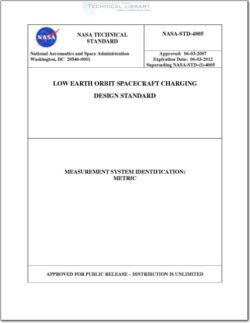NASA-STD-4005

- Version
- 223 Downloads
- 120.29 KB File Size
- 1 File Count
- April 19, 2016 Create Date
- April 19, 2016 Last Updated
Low Earth Orbit Spacecraft Charging Design Standard

The purpose of this standard is to provide a design standard for high—voltage space power
systems (> 55 volts (V)) that operate in the plasma environment associated with LEO (altitude
from 200 and 1000 km and latitude between -50 and +50 degrees). Such power systems,
particularly solar arrays, are the proximate cause of spacecraft charging in LEO; and these
systems can interact with this environment in a number of ways that are potentially destructive to
themselves as well as to the platform or vehicle that has deployed them.
High-voltage systems are used in space for two reasons. The first reason is to save launch
weight. First of all, for the same power level, higher voltages enable use of thinner wires (lighter
cabling). This is true because P = IV, and V = IR, so P = 12R (where P is power, I is current, R is
resistance, and V is voltage). If I is decreased by use of higher V, then thinner wires can be used
with no increase in power loss due to cabling. Of course, if one uses the same cable mass, higher
voltages will enable higher efficiencies, since less power will be lost to resistance in the cables.
For very large power systems, the decrease in cable mass can be substantial.
Second, some spacecraft functions require high voltages. For example, electric propulsion uses
voltages from about 300 V (Hall thrusters) to about 1000 V (ion thrusters). For low—voltage
power systems, conversion of substantial power to high voltages is required for these spacecraft
functions to operate. The weight of the power conversion systems, power management and
distribution (PMAD), can be a substantial fraction of the total power system weight in these
cases. It is more efficient, and can save weight, if the high—voltage functions can be directly
powered from a high-voltage solar array, for instance. If the high-voltage function is electric
propulsion, we call such a system a direct—drive electric propulsion system.
Because of these and other reasons for using high voltages in space, spacecraft designers and
manufacturers are using high voltages more and more. However, the use of high voltages entails
risk; in particular, spacecraft charging in LEO, in contrast to that in geosynchronous earth
orbit (GEO), is caused by exposed high voltages, and can lead to arcing, power drains, power
disruptions, and loss of spacecraft coatings. Thus, system designers need a standard to show
them how to mitigate the spacecraft charging effects of using high voltages in LEO. In addition
to system designers, this document should be useful to project managers, solar array designers,
system engineers, etc.
| File | Action |
|---|---|
| NASA-STD-4005 Low Earth Orbit Spacecraft Charging Design Standard .pdf | Download |

Comment On This Post